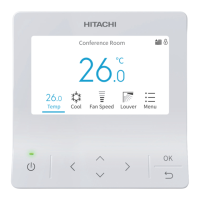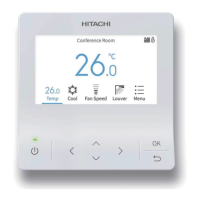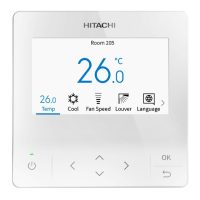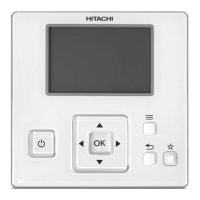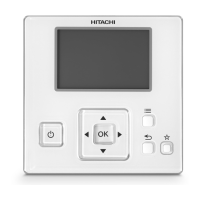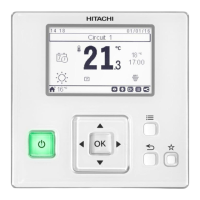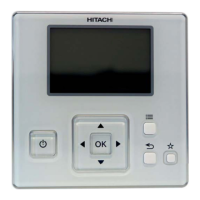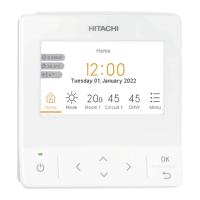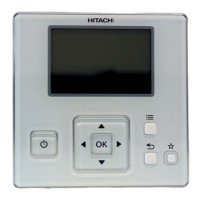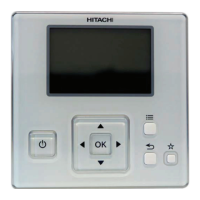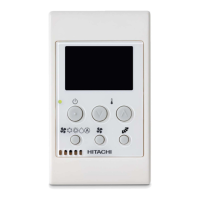Do you have a question about the Hitachi PC-ARFG2-A and is the answer not in the manual?
Defines signal words like WARNING, CAUTION, and NOTICE for hazard indication.
Outlines essential safety measures for personnel during installation.
Precautions to reduce the risk of property damage during operation.
Warnings to reduce risks of electric shock, fire, or explosion during installation.
Safety measures for electrical connections, wiring, and tools.
Identifies components of the controller's main display screen.
Identifies the buttons and directional keys on the controller.
Step-by-step guide for starting and stopping the air conditioner unit.
Explains how to set operation modes like Cool, Heat, Dry, and Auto.
Details how to adjust the target temperature for cooling and heating.
Describes how to select fan speed levels from Low to High.
Explains how to adjust the louver direction and set swing operation.
Covers starting and stopping the air conditioning operation via the controller.
Explains the meaning of various icons displayed on the controller screen.
Guide on accessing and navigating the controller's menu screens.
Introduces the various function settings available in the controller menu.
How to set a simple timer for unit operation start or stop.
Overview of setting up daily and weekly operation schedules.
Detailed steps for setting schedule times and temperatures for each day.
How to temporarily enable or disable the scheduled operation.
Setting specific days as holidays to bypass scheduled operations.
How to reset all operation and holiday schedule settings to default.
Overview of power saving modes and their respective functions.
Instructions on how to turn power saving modes on or off.
Adjusting the level of power saving (Low, Med, High).
Restricts outdoor unit operation noise for quieter environments.
Scheduling power saving and noise reduction at desired times.
Setting specific times for power saving/quiet operation schedules.
Enabling or disabling power saving/quiet schedules.
Shows historical power consumption data for daily, weekly, and yearly periods.
Increases cooling/heating capacity for 30 minutes upon operation start.
Controls discharge air temperature for improved comfort during cooling.
Setting scheduled start/stop for setback mode operation.
Temporarily activates setback operation, often used for vacations.
Raising and lowering the grille for filter cleaning access.
Turns off filter reminder and resets filter usage time.
Suppresses heat exchanger clogs by cleaning with water and defrosting.
Explains Auto-FrostWash and Manual FrostWash functions.
Covers setting FrostWash start, enable/disable, and intervals.
Steps for setting FrostWash intervals and schedules.
Shows the display status and messages during FrostWash operation.
Displays and allows deletion of FrostWash operation history records.
Allows individual adjustment of air direction for multiple air outlets.
How to cancel individual louver settings for specific units.
Fully opens louvers for horizontal air direction adjustment.
Operates the air conditioner and/or heat exchanger modes.
Overview of screen display adjustments including date, time, and brightness.
Setting the current date, time, and preferred time format (12/24 hour).
Changing between 12-hour and 24-hour time display formats.
Adjusting the clock forward or backward for daylight savings.
Adjusting the brightness of the operational indicator light.
Adjusting backlight dim time, off time, and screen theme.
Setting when the backlight dims after a period of inactivity.
Setting when the backlight turns off completely after inactivity.
Selecting between light and dark screen themes for the display.
Settings related to temperature display units and thermistor values.
Setting temperature units (°C/°F) and display width.
Showing or hiding the thermistor temperature on the home screen.
Changing the display language of the controller interface.
Adjusting the sound volume for keypad presses.
Shows service contact details and the latest alarm code.
Explains interface changes when the advanced wired remote is set to hotel mode.
Setting the display language for the controller when in hotel mode.
Setting the timer to automatically turn off the air conditioner.
Resets controller settings to their factory default values.
Explains how alarm codes, unit numbers, and indicators are displayed.
Describes controller behavior during and after a power failure event.
Explains effects of EMI on the unit and troubleshooting steps.
| Type | Remote Control |
|---|---|
| Model | PC-ARFG2-A |
| Brand | Hitachi |
| Category | Remote Control |
| Compatible Devices | Hitachi Air Conditioners |
| Power Source | Battery |
| Battery Type | AAA |
| Battery Quantity | 2 |
